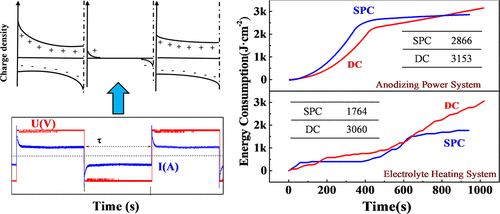当前位置:
X-MOL 学术
›
ACS Appl. Energy Mater.
›
论文详情
Our official English website, www.x-mol.net, welcomes your feedback! (Note: you will need to create a separate account there.)
Symmetric Pulsed Anodizing of Aluminum Foil for Aluminum Electrolytic Capacitors
ACS Applied Energy Materials ( IF 6.4 ) Pub Date : 2020-01-17 00:00:00 , DOI: 10.1021/acsaem.9b02246 Xiang Li 1 , Baige Lin 1 , Lilong Xiong 1 , Xianfeng Du 1
ACS Applied Energy Materials ( IF 6.4 ) Pub Date : 2020-01-17 00:00:00 , DOI: 10.1021/acsaem.9b02246 Xiang Li 1 , Baige Lin 1 , Lilong Xiong 1 , Xianfeng Du 1
Affiliation

|
Alumina as dielectric material is commonly prepared via anodizing high purity etched foils in electrolyte, which vitally determines the performance of aluminum electrolytic capacitor. However, the traditional direct-current (DC) anodizing is limited due to a large amount of Joule heat production, a space charge layer, and unnecessary side reactions, which result in great energy consumption and a poor quality of oxide film. In this work, the symmetric pulsed-current (SPC) anodizing is introduced into the anodization of aluminum foil for electrolytic capacitor. SPC anodizing can contribute to the diffusion of heat during the non-anodization period because of its pulse mode, lowering the thermally induced dissolution of alumina reacted with water. In addition, SPC anodizing can suppress the formation of a space charge layer by alternating the electric field so as to extract impurities out of the oxide film and lower the energy consumption. Moreover, the SPC samples own the denser barrier-type alumina, which have better crystallinity resulting in higher permittivity. Voltage–current output and side reactions during the anodizing process have been analyzed, demonstrating the lower energy consumption and higher production efficiency of the SPC method. In comparison with the DC anodized samples, the specific capacitances of SPC samples are elevated by 10.84% and the energy consumption of the SPC method is decreased by 25.5% in total. Therefore, the SPC anodizing method has a good prospect for industrialization of aluminum electrolytic capacitor.
中文翻译:

铝电解电容器铝箔的对称脉冲阳极氧化
氧化铝通常是通过对电解质中的高纯度蚀刻箔进行阳极氧化而制备的,这决定了铝电解电容器的性能。然而,由于大量的焦耳热产生,空间电荷层和不必要的副反应,传统的直流(DC)阳极氧化受到限制,这导致大量的能量消耗和较差的氧化膜质量。在这项工作中,将对称脉冲电流(SPC)阳极氧化引入电解电容器铝箔的阳极氧化中。SPC阳极氧化由于其脉冲模式,可在非阳极氧化期间促进热量的扩散,从而降低了与水反应的氧化铝的热诱导溶解。此外,SPC阳极氧化可通过交变电场来抑制空间电荷层的形成,从而从氧化膜中提取杂质并降低能耗。而且,SPC样品拥有更致密的势垒型氧化铝,其结晶度更高,介电常数更高。分析了阳极氧化过程中的电压-电流输出和副反应,证明了SPC方法具有较低的能耗和较高的生产效率。与直流阳极氧化样品相比,SPC样品的比电容提高了10.84%,SPC方法的能耗总计降低了25.5%。因此,SPC阳极氧化方法在铝电解电容器的产业化方面具有良好的前景。
更新日期:2020-01-17
中文翻译:

铝电解电容器铝箔的对称脉冲阳极氧化
氧化铝通常是通过对电解质中的高纯度蚀刻箔进行阳极氧化而制备的,这决定了铝电解电容器的性能。然而,由于大量的焦耳热产生,空间电荷层和不必要的副反应,传统的直流(DC)阳极氧化受到限制,这导致大量的能量消耗和较差的氧化膜质量。在这项工作中,将对称脉冲电流(SPC)阳极氧化引入电解电容器铝箔的阳极氧化中。SPC阳极氧化由于其脉冲模式,可在非阳极氧化期间促进热量的扩散,从而降低了与水反应的氧化铝的热诱导溶解。此外,SPC阳极氧化可通过交变电场来抑制空间电荷层的形成,从而从氧化膜中提取杂质并降低能耗。而且,SPC样品拥有更致密的势垒型氧化铝,其结晶度更高,介电常数更高。分析了阳极氧化过程中的电压-电流输出和副反应,证明了SPC方法具有较低的能耗和较高的生产效率。与直流阳极氧化样品相比,SPC样品的比电容提高了10.84%,SPC方法的能耗总计降低了25.5%。因此,SPC阳极氧化方法在铝电解电容器的产业化方面具有良好的前景。


























 京公网安备 11010802027423号
京公网安备 11010802027423号